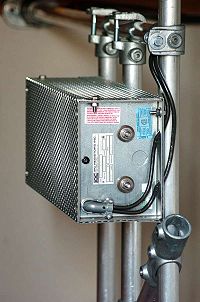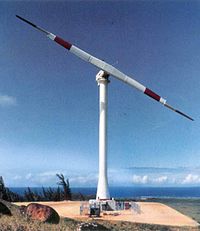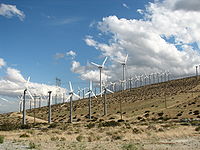- Wind turbine design
-
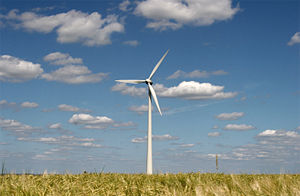 An example of a wind turbine, this 3 bladed turbine is the classic design of modern wind turbines
An example of a wind turbine, this 3 bladed turbine is the classic design of modern wind turbines
Wind turbines History Design Manufacturers Unconventional Wind turbine design is the process of defining the form and specifications of a wind turbine to extract energy from the wind.[1] A wind turbine installation consists of the necessary systems needed to capture the wind's energy, point the turbine into the wind, convert mechanical rotation into electrical power, and other systems to start, stop, and control the turbine.
This article covers the design of horizontal axis wind turbines (HAWT) since the majority of commercial turbines use this design. Contrary to popular belief, considerable attention should be given to the structural and foundation design of HAWTs. This is mainly due to the disproportionate amount that is spent on the foundations as a percentage of the total project cost.
Contents
Design specification
The design specification for a wind-turbine will contain a power curve and guaranteed availability. With the data from the wind resource assessment it is possible to calculate commercial viability.[1] The typical operating temperature range is -20 to 40 °C (-4 to 104 °F). In areas with extreme climate (like Inner Mongolia or Rajasthan) specific cold and hot weather versions are required.
Wind turbines can be designed and validated according to IEC 61400 standards.[2]
Low temperature
Utility-scale wind turbine generators have minimum temperature operating limits which apply in areas that experience temperatures below –20 °C. Wind turbines must be protected from ice accumulation, which can make anemometer readings inaccurate and which can cause high structure loads and damage. Some turbine manufacturers offer low-temperature packages at a few percent extra cost, which include internal heaters, different lubricants, and different alloys for structural elements. If the low-temperature interval is combined with a low-wind condition, the wind turbine will require an external supply of power, equivalent to a few percent of its rated power, for internal heating. For example, the St. Leon, Manitoba project has a total rating of 99 MW and is estimated to need up to 3 MW (around 3% of capacity) of station service power a few days a year for temperatures down to –30 °C. This factor affects the economics of wind turbine operation in cold climates.
Aerodynamics
Main article: Wind turbine aerodynamicsThe aerodynamics of a horizontal-axis wind turbine are not straightforward. The air flow at the blades is not the same as the airflow far away from the turbine. The very nature of the way in which energy is extracted from the air also causes air to be deflected by the turbine. In addition the aerodynamics of a wind turbine at the rotor surface exhibit phenomena that are rarely seen in other aerodynamic fields.
In 1919 the physicist Albert Betz showed that for a hypothetical ideal wind-energy extraction machine, the fundamental laws of conservation of mass and energy allowed no more than 16/27 (59.3%) of the kinetic energy of the wind to be captured. This Betz' law limit can be approached by modern turbine designs which may reach 70 to 80% of this theoretical limit.
Power control
A wind turbine is designed to produce a maximum of power at wide spectrum of wind speeds. All wind turbines are designed for a maximum wind speed, called the survival speed, above which they do not survive. The survival speed of commercial wind turbines is in the range of 40 m/s (144 km/h, 89 MPH) to 72 m/s (259 km/h, 161 MPH). The most common survival speed is 60 m/s (216 km/h, 134 MPH). The wind turbines have three modes of operation:
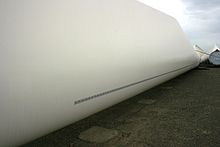 Plastic vortex generator stripes used to control stall characteristics of the blade - in this example protecting the blade from rapid fluctuations in wind speed.
Plastic vortex generator stripes used to control stall characteristics of the blade - in this example protecting the blade from rapid fluctuations in wind speed.
- Below rated wind speed operation
- Around rated wind speed operation (usually at nameplate capacity)
- Above rated wind speed operation
If the rated wind speed is exceeded the power has to be limited. There are various ways to achieve this.
A control system involves three basic elements: sensors to measure process variables, actuators to manipulate energy capture and component loading, and control algorithms to coordinate the actuators based on information gathered by the sensors.[3]
Stall
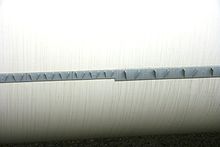 Closeup look at the vortex generators (VGs) - the larger ones are closest to the root of the blade where the boundary layer is thicker(i.e., closest to the hub)
Closeup look at the vortex generators (VGs) - the larger ones are closest to the root of the blade where the boundary layer is thicker(i.e., closest to the hub)
Stalling works by increasing the angle at which the relative wind strikes the blades (angle of attack), and it reduces the induced drag (drag associated with lift). Stalling is simple because it can be made to happen passively (it increases automatically when the winds speed up), but it increases the cross-section of the blade face-on to the wind, and thus the ordinary drag. A fully stalled turbine blade, when stopped, has the flat side of the blade facing directly into the wind.
A fixed-speed HAWT inherently increases its angle of attack at higher wind speed as the blades speed up. A natural strategy, then, is to allow the blade to stall when the wind speed increases. This technique was successfully used on many early HAWTs. However, on some of these blade sets, it was observed that the degree of blade pitch tended to increase audible noise levels.
Vortex generators may be used to control the lift characteristics of the blade. The VGs are placed on the airfoil to enhance the lift if they are placed on the lower (flatter) surface or limit the maximum lift if placed on the upper (higher camber) surface.[4]
Pitch control
Furling works by decreasing the angle of attack, which reduces the induced drag from the lift of the rotor, as well as the cross-section. One major problem in designing wind turbines is getting the blades to stall or furl quickly enough should a gust of wind cause sudden acceleration. A fully furled turbine blade, when stopped, has the edge of the blade facing into the wind.
Loads can be reduced by making a structural system softer or more flexible.[3] This could be accomplished with downwind rotors or with curved blades that twist naturally to reduce angle of attack at higher wind speeds. These systems will be nonlinear and will couple the structure to the flow field - thus, design tools must evolve to model these nonlinearities.
Standard modern turbines all pitch the blades in high winds. Since pitching requires acting against the torque on the blade, it requires some form of pitch angle control, which is achieved with a slewing drive. This drive precisely angles the blade while withstanding high torque loads. In addition, many turbines use hydraulic systems. These systems are usually spring-loaded, so that if hydraulic power fails, the blades automatically furl. Other turbines use an electric servomotor for every rotor blade. They have a small battery-reserve in case of an electric-grid breakdown. Small wind turbines (under 50 kW) with variable-pitching generally use systems operated by centrifugal force, either by flyweights or geometric design, and employ no electric or hydraulic controls.
Fundamental gaps exist in pitch control, limiting the reduction of energy costs, according to a report from a coalition of researchers from universities, industry, and government, supported by the Atkinson Center for a Sustainable Future. Load reduction is currently focused on full-span blade pitch control, since individual pitch motors are the actuators currently available on commercial turbines. Significant load mitigation has been demonstrated in simulations for blades, tower, and drive train. However, there is still research needed, the methods for realization of full-span blade pitch control need to be developed in order to increase energy capture and mitigate fatigue loads.[3]
Other controls
Yawing
Modern large wind turbines are typically actively controlled to face the wind direction measured by a wind vane situated on the back of the nacelle. By minimizing the yaw angle (the misalignment between wind and turbine pointing direction), the power output is maximized and non-symmetrical loads minimized. However, since the wind direction varies quickly the turbine will not strictly follow the direction and will have a small yaw angle on average. The power output losses can simply be approximated to fall with cos3(yaw angle).
Electrical braking
Braking of a small wind turbine can also be done by dumping energy from the generator into a resistor bank, converting the kinetic energy of the turbine rotation into heat. This method is useful if the kinetic load on the generator is suddenly reduced or is too small to keep the turbine speed within its allowed limit.
Cyclically braking causes the blades to slow down, which increases the stalling effect, reducing the efficiency of the blades. This way, the turbine's rotation can be kept at a safe speed in faster winds while maintaining (nominal) power output. This method is usually not applied on large grid-connected wind turbines.
Mechanical braking
A mechanical drum brake or disk brake is used to hold the turbine at rest for maintenance. Such brakes are usually applied only after blade furling and electromagnetic braking have reduced the turbine speed, as the mechanical brakes would wear quickly if used to stop the turbine from full speed. There can also be a stick brake.
Turbine size
 A person standing beside medium size modern turbine blades.
A person standing beside medium size modern turbine blades.For a given survivable wind speed, the mass of a turbine is approximately proportional to the cube of its blade-length. Wind power intercepted by the turbine is proportional to the square of its blade-length. The maximum blade-length of a turbine is limited by both the strength and stiffness of its material.
Labor and maintenance costs increase only gradually with increasing turbine size, so to minimize costs, wind farm turbines are basically limited by the strength of materials, and siting requirements.
Typical modern wind turbines have diameters of 40 to 90 metres (130 to 300 ft) and are rated between 500 kW and 2 MW. As of 2011 the most powerful turbine Enercon_E-126 is rated at 7.5 MW.[5]
Generator
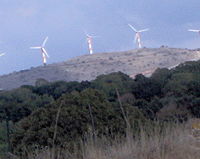 10 Israeli wind turbines in the Golan Heights 600 kW each
10 Israeli wind turbines in the Golan Heights 600 kW each
For large, commercial size horizontal-axis wind turbines, the generator is mounted in a nacelle at the top of a tower, behind the hub of the turbine rotor. Typically wind turbines generate electricity through asynchronous machines that are directly connected with the electricity grid. Usually the rotational speed of the wind turbine is slower than the equivalent rotation speed of the electrical network - typical rotation speeds for a wind generators are 5-20 rpm while a directly connected machine will have an electrical speed between 750-3600 rpm. Therefore, a gearbox is inserted between the rotor hub and the generator. This also reduces the generator cost and weight.
Older style wind generators rotate at a constant speed, to match power line frequency, which allowed the use of less costly induction generators. Newer wind turbines often turn at whatever speed generates electricity most efficiently. This can be solved using multiple technologies such as doubly fed induction generators or full-effect converters where the variable frequency current produced is converted to DC and then back to AC, matching the line frequency and voltage. Although such alternatives require costly equipment and cause power loss, the turbine can capture a significantly larger fraction of the wind energy. In some cases, especially when turbines are sited offshore, the DC energy will be transmitted from the turbine to a central (onshore) inverter for connection to the grid.
Experts from Technical University of Denmark estimate that a geared generator with permanent magnets may use 25 kg/MW of the rare earth element Neodymium, while a gearless may use 250 kg/MW.[6]
Gearless Wind turbine
Commercial size generators have a rotor carrying a field winding so that a rotating magnetic field is produced inside a set of windings called the stator. While the rotating field winding consumes a fraction of a percent of the generator output, adjustment of the field current allows good control over the generator output voltage. Enercon has produced gearless wind turbines with separately excited generators for many years[7], and Siemens produces a gearless "inverted generator" 3MW model[8][9] while developing a 6MW model.[10] This gives better reliability and performance than gear based systems.[citation needed]
In conventional wind turbines, the blades spin a shaft that is connected through a gearbox to the generator. The gearbox converts the turning speed of the blades 15 to 20 rotations per minute for a large, one-megawatt turbine into the faster 1,800 rotations per minute that the generator needs to generate electricity. [11]
The multiple wheels and bearings in a wind turbine gearbox suffer tremendous stress because of wind turbulence, and a small defect in any one component can bring the turbine to a halt. This makes the gearbox the most high-maintenance part of a turbine.
Gearless Wind turbines, often also called direct drive gets rid of the gearbox completely. Instead, the rotor shaft is attached directly to the generator, which spins at the same speed as the blades.
In a turbine generator, magnets spin around a coil to produce current the faster the magnets spin, the more current is induced in the coil. To make up for a direct drive generator's slower spinning rate, the diameter of the generator's rotor is increased hence containing more magnets which lets it create a lot of power when turning slowly. To reduce the generator weight some constructors use permanent magnets in the generators' rotor, while conventional turbine generators use electromagnets copper coils fed with electricity from the generator itself. Building smaller generators with important torque is still an active research area to enhance their competitiveness.
Gearless Wind turbine are often heavier than gear based Wind turbines, but they need less maintenance as they contain less moving parts, and are hence indicated for offshore turbines, because doing maintenance at sea is a lot more complex and expensive than on the ground.
Blades
Blade design
The ratio between the speed of the blade tips and the speed of the wind is called tip speed ratio. High efficiency 3-blade-turbines have tip speed/wind speed ratios of 6 to 7. Modern wind turbines are designed to spin at varying speeds (a consequence of their generator design, see above). Use of aluminum and composite materials in their blades has contributed to low rotational inertia, which means that newer wind turbines can accelerate quickly if the winds pick up, keeping the tip speed ratio more nearly constant. Operating closer to their optimal tip speed ratio during energetic gusts of wind allows wind turbines to improve energy capture from sudden gusts that are typical in urban settings.
In contrast, older style wind turbines were designed with heavier steel blades, which have higher inertia, and rotated at speeds governed by the AC frequency of the power lines. The high inertia buffered the changes in rotation speed and thus made power output more stable.
The speed and torque at which a wind turbine rotates must be controlled for several reasons:
- To optimize the aerodynamic efficiency of the rotor in light winds.
- To keep the generator within its speed and torque limits.
- To keep the rotor and hub within their centrifugal force limits. The centrifugal force from the spinning rotors increases as the square of the rotation speed, which makes this structure sensitive to overspeed.
- To keep the rotor and tower within their strength limits. Because the power of the wind increases as the cube of the wind speed, turbines have to be built to survive much higher wind loads (such as gusts of wind) than those from which they can practically generate power. Since the blades generate more torsional and vertical forces (putting far greater stress on the tower and nacelle due to the tendency of the rotor to precess and nutate) when they are producing torque, most wind turbines have ways of reducing torque in high winds.
- To enable maintenance. Since it is dangerous to have people working on a wind turbine while it is active, it is sometimes necessary to bring a turbine to a full stop.
- To reduce noise. As a rule of thumb, the noise from a wind turbine increases with the fifth power of the relative wind speed (as seen from the moving tip of the blades). In noise-sensitive environments, the tip speed can be limited to approximately 60 m/s (200 ft/s).
It is generally understood that noise increases with higher blade tip speeds. To increase tip speed without increasing noise would allow reduction the torque into the gearbox and generator and reduce overall structural loads, thereby reducing cost.[3] The reduction of noise is linked to the detailed aerodynamics of the blades, especially factors that reduce abrupt stalling. The inability to predict stall restricts the development of aggressive aerodynamic concepts. .[3]
Blade count
 The NASA Mod-0 research wind turbine at Glenn Research Center's Plum Brook station in Ohio tested a one-bladed rotor configuration
The NASA Mod-0 research wind turbine at Glenn Research Center's Plum Brook station in Ohio tested a one-bladed rotor configuration
The determination of the number of blades involves design considerations of aerodynamic efficiency, component costs, system reliability, and aesthetics. Noise emissions are affected by the location of the blades upwind or downwind of the tower and the speed of the rotor. Given that the noise emissions from the blades' trailing edges and tips vary by the 5th power of blade speed, a small increase in tip speed can make a large difference.
Wind turbines developed over the last 50 years have almost universally used either two or three blades. Aerodynamic efficiency increases with number of blades but with diminishing return. Increasing the number of blades from one to two yields a six percent increase in aerodynamic efficiency, whereas increasing the blade count from two to three yields only an additional three percent in efficiency. Further increasing the blade count yields minimal improvements in aerodynamic efficiency and sacrifices too much in blade stiffness as the blades become thinner.
Component costs that are affected by blade count are primarily for materials and manufacturing of the turbine rotor and drive train. Generally, the fewer the number of blades, the lower the material and manufacturing costs will be. In addition, the fewer the number of blades, the higher the rotational speed can be. This is because blade stiffness requirements to avoid interference with the tower limit how thin the blades can be manufactured, but only for upwind machines; deflection of blades in a downwind machine results in increased tower clearance. Fewer blades with higher rotational speeds reduce peak torques in the drive train, resulting in lower gearbox and generator costs.
System reliability is affected by blade count primarily through the dynamic loading of the rotor into the drive train and tower systems. While aligning the wind turbine to changes in wind direction (yawing), each blade experiences a cyclic load at its root end depending on blade position. This is true of one, two, three blades or more. However, these cyclic loads when combined together at the drive train shaft are symmetrically balanced for three blades, yielding smoother operation during turbine yaw. Turbines with one or two blades can use a pivoting teetered hub to also nearly eliminate the cyclic loads into the drive shaft and system during yawing.
Finally, aesthetics can be considered a factor in that some people find that the three-bladed rotor is more pleasing to look at than a one- or two-bladed rotor.
Blade materials
Wood and canvas sails were used on early windmills due to their low price, availability, and ease of manufacture. Smaller blades can be made from light metals such as aluminum. These materials, however, require frequent maintenance. Wood and canvas construction limits the airfoil shape to a flat plate, which has a relatively high ratio of drag to force captured (low aerodynamic efficiency) compared to solid airfoils. Construction of solid airfoil designs requires inflexible materials such as metals or composites.
New wind turbine designs push power generation from the single megawatt range to upwards of 10 megawatts using larger and larger blades. A larger area effectively increases the tip-speed ratio of a turbine at a given wind speed, thus increasing its energy extraction.[12] Computer-aided engineering software such as HyperSizer (originally developed for spacecraft design) can be used to improve blade design.[13][14]
Current[when?] production wind turbine blades are as large as 100 meters in diameter with prototypes in the range of 110 to 120 meters. In 2001, an estimated 50 million kilograms of fiberglass laminate were used in wind turbine blades.[15]
An important goal of larger blade systems is to control blade weight. Since blade mass scales as the cube of the turbine radius, loading due to gravity constrains systems with larger blades.[16]
Manufacturing blades in the 40 to 50 meter range involves proven fiberglass composite fabrication techniques. Manufactures such as Nordex and GE Wind use an infusion process. Other manufacturers use variations on this technique, some including carbon and wood with fiberglass in an epoxy matrix. Options also include prepreg fiberglass and vacuum-assisted resin transfer molding. Each of these options use a glass-fiber reinforced polymer composite constructed with differing complexity. Perhaps the largest issue with more simplistic, open-mold, wet systems are the emissions associated with the volatile organics released. Preimpregnated materials and resin infusion techniques avoid the release of volatiles by containing all reaction gases. However, these contained processes have their own challenges, namely the production of thick laminates necessary for structural components becomes more difficult. As the preform resin permeability dictates the maximum laminate thickness, bleeding is required to eliminate voids and insure proper resin distribution.[15] One solution to resin distribution a partially preimpregnated fiberglass. During evacuation, the dry fabric provides a path for airflow and, once heat and pressure are applied, resin may flow into the dry region resulting in a thoroughly impregnated laminate structure.[15]
Epoxy-based composites have environmental, production, and cost advantages over other resin systems. Epoxies also allow shorter cure cycles, increased durability, and improved surface finish. Prepreg operations further reduce processing time over wet lay-up systems. As turbine blades pass 60 meters, infusion techniques become more prevalent; the traditional resin transfer moulding injection time is too long as compared to the resin set-up time, limiting laminate thickness. Injection forces resin through a thicker ply stack, thus depositing the resin where in the laminate structure before gelatin occurs. Specialized epoxy resins have been developed to customize lifetimes and viscosity.[17]
Carbon fiber-reinforced load-bearing spars can reduce weight and increase stiffness. Using carbon fibers in 60 meter turbine blades is estimated to reduce total blade mass by 38% and decrease cost by 14% compared to 100% fiberglass. Carbon fibers have the added benefit of reducing the thickness of fiberglass laminate sections, further addressing the problems associated with resin wetting of thick lay-up sections. Wind turbines may also benefit from the general trend of increasing use and decreasing cost of carbon fiber materials.[15]
Tower
Typically, 2 types of towers exist: floating towers and land-based towers.
Tower height
Wind velocities increase at higher altitudes due to surface aerodynamic drag (by land or water surfaces) and the viscosity of the air. The variation in velocity with altitude, called wind shear, is most dramatic near the surface.
Wind turbines generating electricity at the San Gorgonio Pass Wind Farm.
Typically, in daytime the variation follows the wind profile power law, which predicts that wind speed rises proportionally to the seventh root of altitude. Doubling the altitude of a turbine, then, increases the expected wind speeds by 10% and the expected power by 34%. To avoid buckling, doubling the tower height generally requires doubling the diameter of the tower as well, increasing the amount of material by a factor of at least four.
At night time, or when the atmosphere becomes stable, wind speed close to the ground usually subsides whereas at turbine hub altitude it does not decrease that much or may even increase. As a result the wind speed is higher and a turbine will produce more power than expected from the 1/7 power law: doubling the altitude may increase wind speed by 20% to 60%. A stable atmosphere is caused by radiative cooling of the surface and is common in a temperate climate: it usually occurs when there is a (partly) clear sky at night. When the (high altitude) wind is strong (a 10-meter (33 ft) wind speed higher than approximately 6 to 7 m/s (20–23 ft/s)) the stable atmosphere is disrupted because of friction turbulence and the atmosphere will turn neutral. A daytime atmosphere is either neutral (no net radiation; usually with strong winds and/or heavy clouding) or unstable (rising air because of ground heating—by the sun). Here again the 1/7 power law applies or is at least a good approximation of the wind profile. Indiana had been rated as having a wind capacity of 30,000 MW, but by raising the expected turbine height from 50 m to 70 m, the wind capacity estimate was raised to 40,000 MW, and could be double that at 100 m.[18]
For HAWTs, tower heights approximately two to three times the blade length have been found to balance material costs of the tower against better utilisation of the more expensive active components.
Foundations
Wind turbines, by their nature, are very tall slender structures,[19] this can cause a number of issues when the structural design of the foundations are considered.
The foundations for a conventional engineering structure are designed mainly to transfer the vertical load (dead weight) to the ground, this generally allows for a comparatively unsophisticated arrangement to be used. However in the case of wind turbines, due to the high wind and environmental loads experienced there is a significant horizontal dynamic load that needs to be appropriately restrained.
This loading regime causes large moment loads to be applied to the foundations of a wind turbine. As a result, considerable attention needs to be given when designing the footings to ensure that the turbines are sufficiently restrained to operate efficiently.[20] In the current Det Norske Veritas (DNV) guidelines for the design of wind turbines the angular deflection of the foundations are limited to 0.5°,[21] DNV guidelines regarding earthquakes suggest that horizontal loads are larger than vertical loads for offshore wind turbines, while guidelines for tsunamis only suggest designing for maximum sea waves.[22]
Scale model tests using a 50g centrifuge are being performed at the Technical University of Denmark to test monopile foundations for offshore wind turbines at 30-50m water depth.[23]
Costs
The modern wind turbine is a complex and integrated system. Structural elements comprise the majority of the weight and cost. All parts of the structure must be inexpensive, lightweight, durable, and manufacturable, under variable loading and environmental conditions. Turbine systems that have fewer failures, require less maintenance, are lighter and last longer will lead to reducing the cost of wind energy.
One way to achieve this is to implement well-documented, validated analysis codes, according to a 2011 report from a coalition of researchers from universities, industry, and government, supported by the Atkinson Center for a Sustainable Future.[3]
See also
- Brushless wound-rotor doubly fed electric machine
- Vertical-axis wind turbine
- Wind farm
- Wind turbine aerodynamics
- Wind turbine
References
- ^ a b "Efficiency and performance". UK Department for Business, Enterprise & Regulatory Reform. http://www.berr.gov.uk/files/file17821.pdf. Retrieved 2007-12-29.
- ^ International Standard IEC 61400-1, Third Edition International Electrotechnical Commission, August 2005. Accessed: 12 March 2011.
- ^ a b c d e f Alan T. Zehnder and Zellman Warhaft (27 July 2011). "University Collaboration on Wind Energy". Cornell University Atkinson Center for a Sustainable Future. http://www.sustainablefuture.cornell.edu/attachments/2011-UnivWindCollaboration.pdf. Retrieved 22 August 2011.
- ^ Johnson, Scott J.; van Dam, C.P. and Berg, Dale E. (2008). "Active Load Control Techniques for Wind Turbines". Sandia National Laboratory. http://www.sandia.gov/wind/other/084809.pdf. Retrieved 13 September 2009.
- ^ Belgium inaugurates wind farm with largest wind turbines
- ^ Wittrup, Sanne. PMs cause production problems English translation Ing.dk, 1 November 2011. Accessed: 1 November 2011.
- ^ Anatomy of an Enercon direct drive wind turbine
- ^ Fairly, Peter. Wind Turbines Shed Their Gears Technology Review, 27 April 2010. Retrieved: 22 September 2010.
- ^ Wittrup, Sanne. First Siemens gearless Ing.dk, 11 August 2010. Retrieved: 15 September 2010.
- ^ Wittrup, Sanne. 6MW Siemens gearless Ing.dk, 15 September 2010. Retrieved: 15 September 2010.
- ^ How It Works: Gearless wind Turbine
- ^ Zbigniew Lubosny (2003). Wind Turbine Operation in Electric Power Systems: Advanced Modeling (Power Systems). Berlin: Springer. ISBN 3-540-40340-X.
- ^ "Materials and design methods look for the 100-m blade". Windpower Engineering. 10 May 2011. http://www.windpowerengineering.com/design/mechanical/materials-and-design-methods-look-for-the-100-m-blade/. Retrieved 22 August 2011.
- ^ Craig S. Collier (1 October 2010). "From Aircraft Wings to Wind Turbine Blades: NASA Software Comes Back to Earth with Green Energy Applications". NASA Tech Briefs. http://www.techbriefs.com/component/content/article/8602. Retrieved 22 August 2011.
- ^ a b c d Griffin, Dayton A.; Ashwill, Thomas D. (2003). "Alternative Composite Materials for Megawatt-Scale Wind Turbine Blades: Design Considerations and Recommended Testing". Journal of Solar Energy Engineering 125 (4): 515. doi:10.1115/1.1629750.
- ^ Ashwill, T; Laird D (January 2007). "Concepts to Facilitate Very Large Blades". 45th AIAA Aerospace Sciences Meeting and Exhibit. AIAA-2007-0817. http://www.sandia.gov/wind/asme/AIAA-2007-0817A.pdf.
- ^ Christou, P (2007). "Advanced materials for turbine blade manufacture". Reinforced Plastics 51 (4): 22. doi:10.1016/S0034-3617(07)70148-0.
- ^ Indiana's Renewable Energy Resources
- ^ Lombardi, D. (2010). Long Term Performance of Mono-pile Supported Offshore Wind Turbines. Bristol: University of Bristol.
- ^ Cox, J. A., & Jones, C. (2010). Long-Term Performance of Suction Caisson Supported Offshore Wind Turbines. Bristol: University of Bristol.
- ^ Det Norske Veritas (2001). Guidelines for Design of Wind Turbines. Copenhagen: Det Norske Veritas.
- ^ DNV-OS-J101 Design of Offshore Wind Turbine Structures Det Norske Veritas. Accessed: 12 March 2011.
- ^ Rasmussen, Daniel. Wind turbine foundations at 50g (in Danish) Ing.dk, 26 October 2010. 6minute Video Retrieved: 25 November 2010.
External links
- Department of Energy- Energy Efficiency and Renewable Energy
- RenewableUK - Wind Energy Reference and FAQs
- How is Wind turbine made
Wind power Wind power 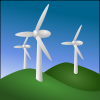
Wind power by country Wind turbines - Aerodynamics
- Airborne
- Darrieus
- Design
- Floating
- Savonius
- Quietrevolution
- Small
- Unconventional
- Vertical axis
- Devices in use
Wind power industry - Consultants
- Manufacturers
- Software
- Wind farm management
Wind farms - Community-owned
- List of offshore wind farms
- List of onshore wind farms
Concepts - Betz' law
- Capacity factor
- EROEI
- Grid energy storage
- HVDC
- Intermittency
- Net energy gain
- Storage
- Subsidies
- Wind power forecasting
- Wind profile power law
- Wind resource assessment
Categories:- Wind turbines
Wikimedia Foundation. 2010.


